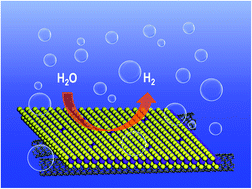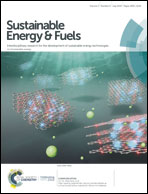Unravelling the synergy effects of defect-rich 1T-MoS2/carbon nanotubes for the hydrogen evolution reaction by experimental and calculational studies†
Abstract
Molybdenum disulfide (MoS2) has attracted considerable attention as a promising alternative to Pt-based electrocatalysts for the hydrogen evolution reaction (HER). However, MoS2 suffers from limited active sites and low intrinsic conductivity. In this study, we report a facile hydrothermal strategy for developing a defect-rich 1T-MoS2/carbon nanotubes (1T-MoS2/CNTs) composite. In comparison to 1T-MoS2, CNTs, and pristine MoS2, the 1T-MoS2/CNTs composite demonstrates higher electrocatalytic performance for the HER, with a small Tafel slope of 54 mV dec−1 and a very low overpotential of 173 mV at a current density of 10 mA cm−2. Moreover, density functional theory (DFT) calculations show that the density of states (DOS) for defect 1T-MoS2 displays a small band gap semiconducting nature; meanwhile, the defect 1T-MoS2/CNT system shows metallic behavior. In addition, defect 1T-MoS2/CNT shows a lower free energy change for hydrogen adsorption (ΔGH*) than defect 1T-MoS2, pure 1T-MoS2 and 1H-MoS2. We believe that this excellent HER performance should be attributed to synergy effects between 1T-MoS2 and the CNTs, including the relatively high number of active sites, defect-rich structures, and high electronic conductivity of the 1T-MoS2/CNTs and the strong interaction between the 1T-MoS2 and the CNTs. Thus, this work provides a novel and simple method for designing 1T-MoS2/CNTs composites for energy storage applications.



 Please wait while we load your content...
Please wait while we load your content...